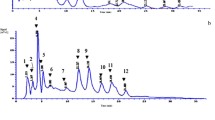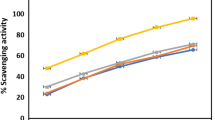Abstract
The present investigation was to evaluate the antioxidant and antibacterial activities of hexane and methanol extracts from Origanum vulgare ssp. hirtum and Thymus vulgaris (Komotini, Greece). The methanol extracts of oregano and thyme against DPPH radical were more active than the hexane extracts (mean values 0.94 and 0.47, respectively) and oregano exhibited stronger activity than thyme (mean values 0.82 and 0.55, respectively). The results from the β-carotene/linoleic acid assay showed that all plant extracts inhibited linoleic acid oxidation up to 70.78±1.17%. The oregano extracts exhibited the strongest inhibition against Escherichia coli, Listeria monocytogenes, and Staphylococcus aureus using the disc diffusion assay. The chemical composition of the hexane and methanol extracts, by using GC-MS, showed that carvacrol, thymol, and p-cymene were the most prominent compounds. The methanol extract of oregano was found the most potent antioxidant with the highest content of total phenolics (138.92 mg GA/g extract) and carvacrol (76.7%).
Similar content being viewed by others
References
Dorman HJD, Deans SG. Antimicrobial agents from plants: Antibacterial activity of plant volatile oils. J. Appl. Microbiol. 88: 308–316 (2000)
Vardar-Unlu G, Candan F, Sökmen A, Daferera D, Polisiou M, Sökmen M, Dönmez E, Tepe B. Antibacterial and antioxidant activity of the essential oil and methanol extracts of Thymus pectinatus (Lamiaceae). J. Agr. Food Chem. 51: 63–67 (2003)
Martos MV, Navajas YR, Lopez JF, Alvarez AP. Antibacterial activity of different essential oils obtained from spices widely used in Mediterranean diet. Int. J. Food Sci. Tech. 43: 526–531 (2008)
Kaur C, Kapoor HC. Antioxidants in fruits and vegetables-the millennium’s health. Int. J. Food Sci. Tech. 36: 703–725 (2001)
Dorman HJ, Bachmayer O, Kosar M, Hiltunen R. Antioxidant properties of aqueous extracts from selected Lamiaceae species grown in Turkey. J. Agr. Food Chem. 52: 762–770 (2004)
Tsimogiannis D, Stavrakaki M, Oreopoulou V. Isolation and characterization of antioxidant components from oregano (Origanum heracleoticum). Int. J. Food Sci. Tech. 41: 39–48 (2006)
Tepe B, Daferera D, Sokmen M, Polissiou M, Sokmen A. In vitro antimicrobial and antioxidant activities of the essential oil and various extracts of Thymus eigii M. (Lamiaceae). J. Agr. Food Chem. 52: 1132–1137 (2004)
Lagouri V, Boskou D. Nutrient antioxidants in oregano. Int. J. Food Sci. Nutr. 47: 493–497 (1996)
Zivanovic S, Chi S, Draughon AF. Antimicrobial activity of chitosan films enriched with essential oils. J. Food Sci. 70: 45–51 (2005)
Burt SA, Reinders RD. Antibacterial activity of selected plant essential oils against Escherichia coli O157:H7. Lett. Appl. Microbiol. 36: 162–167 (2003)
Brand-Williams W, Cuvelier ME, Berset C. Use of free radical method to evaluate antioxidant activity. Lebensm.-Wiss. Technol. 28: 25–30 (1995)
Mallet JF, Cerati C, Ucciani E, Gamisana J, Gruber M. Antioxidant activity of fresh pepper cultivars. Food Chem. 49: 61–65 (1994)
AOAC. Official Method of Analysis of AOAC Intl. 16th ed. Method 952.03. Association of Official Analytical Chemists, Arlington, VA, USA (1995)
Gurbuz O, Rouseff JM, Rouseff RL. Comparison of aroma volatiles in commercial Merlot and Cabernet Sauvignon wines using gas chromatography-olfactometry and gas chromatography-mass spectrometry. J. Agr. Food Chem. 5: 3990–3996 (2006)
Soares JR, Dins TCP, Cunha AP, Ameida LM. Antioxidant activity of some extracts of Thymus zygis. Free Radical Res. 26: 469–478 (1997)
Rice-Evans C, Miller N, Paganga G. Structure-antioxidant activity relationships of flavonoids and phenolic acids. Free Radical Bio. Med. 20: 933–956 (1996)
Katsube T, Tabata H, Ohta Y, Yamasaki Y, Amuurad E, Shiwaku K. Screening for antioxidant activity in edible plant products: Comparison of low-density lipoprotein oxidation assay, DPPH radical scavenging assay and Folin-Ciocalteau assay. J. Agr. Food Chem. 52: 2391–2396 (2004)
Katalinic V, Milos M, Jukic M. Screening of 70 medicinal plant extracts for antioxidant capacity and total phenols. Food Chem. 94: 550–557 (2006)
Hinneburg I, Dorman HJD, Hiltunen R. Antioxidant activities of extracts from selected culinary herbs and spices. Food Chem. 97: 122–129 (2006)
Zheng W, Wang SY. Antioxidant activity and phenolic compounds in selected herbs. J. Agr. Food Chem. 49: 5165–5170 (2001)
Friedman M, Henika PR, Mandrell RE. Bactericidal activities of plant essential oils and some of their isolated constituents against Campylobacter jejuni, Escherichia coli, Listeria monocytogenes, and Salmonella enterica. J. Food Protect. 65: 1545–1560 (2002)
Elgayyar M, Draughon FA, Golden DA, Mount JR. Antimicrobial activity of essential oils from plants against selected pathogenic and saprophytic microorganisms. J. Food Protect. 64: 1019–1024 (2001)
Peltoketo A, Dorman HJD, Yrjonen T, Laasko I, Vuorela H, Hiltunen R. Antioxidant properties of volatile oils and aqueous fractions of selected aromatic and medicinal plants. Phytomedicine, Suppl II, p. 75. In: 3rd International Conference on Phytomedicine. Munich, Germany (2001)
Ceylan A, Bayram E, Geren H. Investigation on agronomical and quality characteristics of improved clones in Origanum (Origanum onites L.) breeding. Turk. J. Agr. For. 23: 1163–1168 (1999)
Aridogan BC, Baydar H, Kaya S, Demirci M, Ozbasar D, Mumcu E. Antimicrobial activity and chemical composition of some essential oils. Arch. Pharm. Res. 25: 860–864 (2002)
Kokkini S, Karousou R, Hanlidou E, Lanaras T. Essential oil composition of Greek (Origanum vulgare ssp. hirtum) and Turkish (O. onites) oregano: A tool for their distinction. J. Essent. Oil Res. 16: 334–338 (2004)
Baranauskiene R, Venskutonis PR, Viskelis P, Dambrauskiene E. Influence of nitrogen fertilizers on the yield and composition of thyme (Thymus vulgaris). J. Agr. Food Chem. 51: 7751–7758 (2003)
Salzer UJ. The analysis of essential oils and extracts (oleoresins) from seasonings — A critical review. Crit. Rev. Food Sci. 9: 345–373 (1977)
Lattaoui N, Tantaoui-Elaraki A. Individual and combined antibacterial activity of the main components of three thyme essential oils. Riv. Ital. EPPOS 13: 13–19 (1994)
Demetzos C, Perdetzoglou DK. Composition and antimicrobial studies of the oils of Origanum calcaratum Juss. and O. scabrum Boiss. et Heldr. from Greece. J. Essent. Oil Res. 13: 460–462 (2001)
Arras G, Grella GE. Wild thyme, Thymus capitatus, essential oil seasonal changes and antimycotic activity. J. Hortic. Sci. 67: 197–202 (1992)
Author information
Authors and Affiliations
Corresponding author
Rights and permissions
About this article
Cite this article
Lagouri, V., Guldas, M. & Gurbuz, O. In vitro antioxidant/free radical scavenging and antibacterial properties of endemic oregano and thyme extracts from Greece. Food Sci Biotechnol 20, 1487–1493 (2011). https://doi.org/10.1007/s10068-011-0206-3
Received:
Revised:
Accepted:
Published:
Issue Date:
DOI: https://doi.org/10.1007/s10068-011-0206-3




